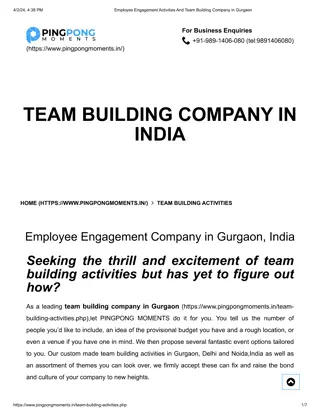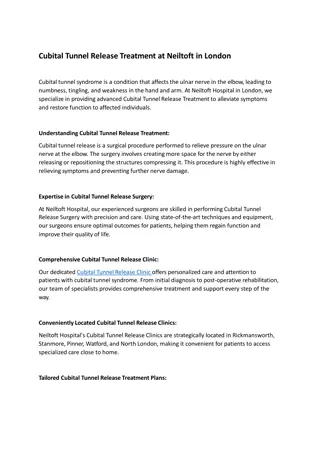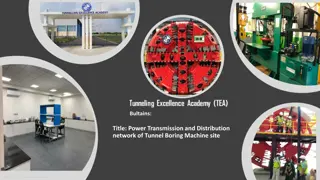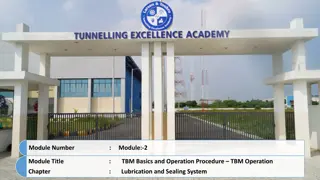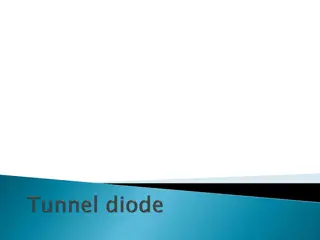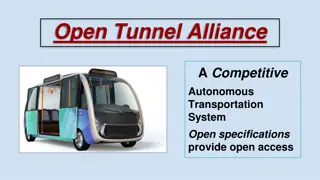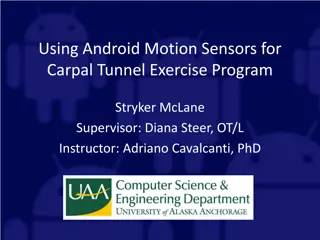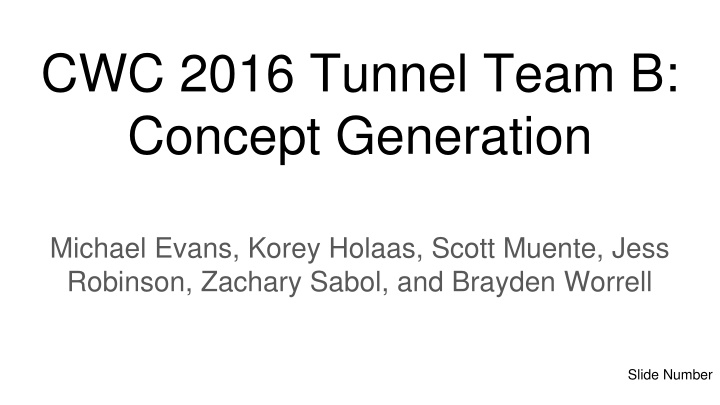
Collegiate Wind Competition 2016 Tunnel Team B Project Overview
Discover the journey of Collegiate Wind Competition 2016 Team B as they delve into the electric side of Wind Tunnel Turbine Design, focusing on controls, power electronics, and software. Uncover the customer and engineering requirements, various designs considered for controls, load, and power electronics, and the innovative concepts explored by the team.
Uploaded on | 0 Views
Download Presentation

Please find below an Image/Link to download the presentation.
The content on the website is provided AS IS for your information and personal use only. It may not be sold, licensed, or shared on other websites without obtaining consent from the author. If you encounter any issues during the download, it is possible that the publisher has removed the file from their server.
You are allowed to download the files provided on this website for personal or commercial use, subject to the condition that they are used lawfully. All files are the property of their respective owners.
The content on the website is provided AS IS for your information and personal use only. It may not be sold, licensed, or shared on other websites without obtaining consent from the author.
E N D
Presentation Transcript
CWC 2016 Tunnel Team B: Concept Generation Michael Evans, Korey Holaas, Scott Muente, Jess Robinson, Zachary Sabol, and Brayden Worrell Slide Number
PROJECT DESCRIPTION Collegiate Wind Competition 2016 Tunnel Team B covers the electric side of the Wind Tunnel Turbine Design: Controls, Load, Power Electronics, and Software. Earn points on the Tunnel Tests in various categories, such as Safety, Power Curve Performance, and others. The Tunnel Design should be a model of the Deployment Team and the Business Team s work. Name - Slide Number
REQUIREMENTS Customer Requirements Power Curve Performance (50), Control of Rated Power (40), Control of Rotor Speed (40), Cut-in Wind Speed (25), Safety (25), Supply a Load System (25), Provide Appropriate Wiring/Connections (25), Redundant Braking System (20), Durability (15), and Small Scale (10). Engineering Requirements Produce Sufficient Continuous Power, Withstand High Wind Speeds, Design an Innovative Load, Fit in the Testing Space, Quickly Assemble and Disassemble, and Shut Down on Push Button Activation & Loss of Power. Name - Slide Number
DESIGNS CONSIDERED - CONTROLS Investigated 6 different brake systems: AC Wye-Connected Brake Connect +, -, and GND leads of generator Latching relay used to toggle connections, other options possible [J1] DC Dynamic Brake Connect + and - leads of DC converter, via latching relay Disk Brake - Hydraulically Controlled Disk Brake - Pneumatically Controlled Jess Robinson - Slide Number Hysteresis Brake [J2]
DESIGNS CONSIDERED - LOAD Diversion Load - A battery bank and a resistive load that switch when the battery is fully charged Smart Material Load - Flexible materials that change in shape based changes in their electric field Butterfly Smart Materials (nature inspired) - A smart material load that is shaped like a butterfly and flaps its wing when it is being charged Heat Sink Load - A fully resistive load that heats up and a heat sink fan to keep it from over heating Electric Eel Discharge (nature inspired) - A load that discharges all of its power when the turbine brakes Name - Slide Number
DESIGNS CONSIDERED - POWER ELECTRONICS Rectification Passive Rectification with Shottky Diodes - Large voltage drop across Rectifier, works without input. Active Rectification with MOSFETs/Relays - Lower voltage drop leads to increased efficiency, more difficult to control. Active Rectification with MOS-controlled Thyristors - Higher voltage drop, less complex to operate, and needs to be activated less often. DC/DC Conversion Buck-Boost Converter - Inverting non-isolated single inductor step-up or step-down DC-DC converter. Name - Slide Number
DESIGNS CONSIDERED - SOFTWARE Use Loss of Power Algorithms to Respond to Push Break - If power is disconnected, do the same thing as if the button was pressed, and vice versa. Infrared Detector to Measure Instantaneous RPM and TSR - Use an emitter and sensor to measure the reflected IR beam, and obtain tip-speed ratio. PID and PWM to Direct Controls - Proportional Integral Derivative and Pulse- Width Modulation coding helps controls be more efficient. Sensors built into Power Electronics - Using sensing circuits (voltage and current) to calculate RPM, Power, and TSR. Arduino Sleep Library - Use the Sleep function to lower power losses (20 * 10^- 6 Amps) [B1]. Name - Slide Number
DESIGNS SELECTED - CONTROLS Brake Systems Criteria Weight DC Brake Hysteresis Brake AC Brake Power Consumption 35% 7 5 9 Complexity 25% 9 6 7 Size 10% 9 4 8 Braking Power 20% 6 9 7 Cost 10% 9 6 9 Total 100% 7.7 6.05 8 Jess Robinson - Slide Number
DESIGNS SELECTED - LOAD Criteria Weight Diversion load Heat Sink Eel Discharge Cost 30% 8 8 6 Simplicity 30% 8 9 5 Creativity 20% 7 4 9 Functionality 20% 8 5 7 Total 100% 7.8 6.9 6.5 Name - Slide Number
DESIGNS SELECTED - POWER ELECTRONICS DC/DC Conversion Rectification Criteria Weight Flyback SEPIC Buck- Boost Criteria Weight Passive MCT MOSFET Voltage Drop 40% 3 5 8 Power Losses 15% 8 8 4 Power Draw 30% 4 4 7 Size 25% 6 4 8 Cost 10% 7 6 8 Complex 20% 8 2 4 Complexity 20% 7 5 8 Cost 10% 6 3 5 Output Range 30% 4 2 8 Total 100% 5.4 3.9 6.6 Total 100% 6.0 3.9 7.4 Name - Slide Number
DESIGNS SELECTED - SOFTWARE Criteria Weight LoP and Button Sleep Library PID and PWM Power Draw 35% 6 7 5 Braking 25% 7 5 8 Responsive 25% 6 6 8 Difficulty 15% 6 8 5 Total 100% 6.25 6.40 6.50 Name - Slide Number
SCHEDULE - NOVEMBER Name - Slide Number
SCHEDULE - DECEMBER Name - Slide Number
BUDGET Brake Systems: Primary brake system: TE RT314A06 latching relay, unit price: $2.47 Redundant brake system: ST P75NF75 MOSFET (transistor), unit price: < $1 Bulk reel of 22 AWG wire: $6:49 Liquid electrical tape: $7 Manual override button: $8 JST RCY plug: $0.50 Name - Slide Number
CONCLUSION Controls Idea: Connecting +, -, GND of AC output together to brake the turbine Load Idea: Diversion Load that is part battery bank and part resistive load Power Electronics Ideas: Active Rectification with MOSFETs and Flyback Converter Software Idea: PID and PWM to Direct Controls Name - Slide Number
REFERENCES [1] - Arduino Playground - ArduinoSleepCode [online] Available: http://playground.arduino.cc [2]'THEORYOF DIELECTRIC ELASTOMERS', Acta Mechanica Solida Sinica, vol. 23, no. 6, pp. 1-2, 2010. [3]'Finite Element Modeling of the Sensing and Energy Harvesting Performance in Ionic Polymer Metal Composites', Electroactive Polymer Actuators and Devices, vol. 8687, pp. 1-5, 2013. [J1] TE Connectivity Relay Products, Power PCB relay RT1 bistable, RT314A06 datasheet, Oct. 2014. [J2] Magtrol, Hysteresis brakes and clutches [Online Datasheet]. Available: http://www.electro- meters.com/Assets/PDF_files/Magtrol/Dynamometers/hysteresis.pdf [J3] (2008). Feet used to slow landings: True frogs [Online]. Available: http://www.asknature.org/strategy/2a1f9703445f72a43e51800965fd03fa Slide Number
QUESTIONS? Slide Number

